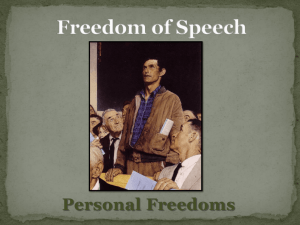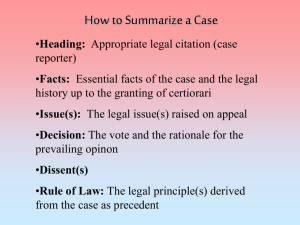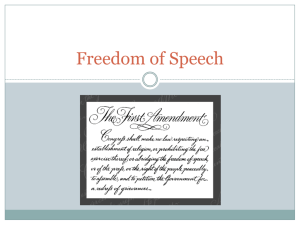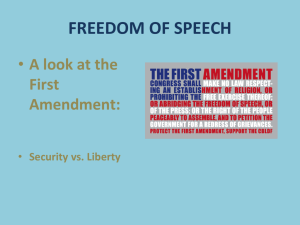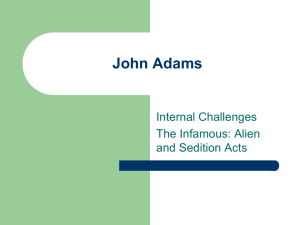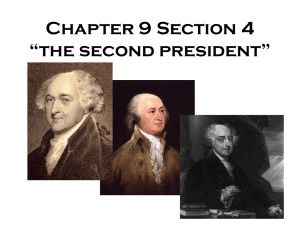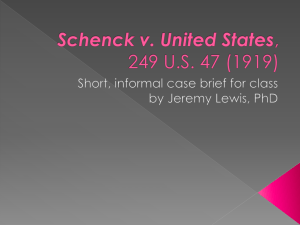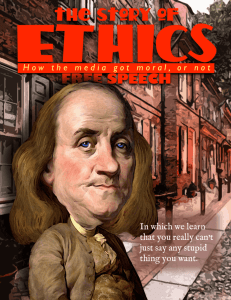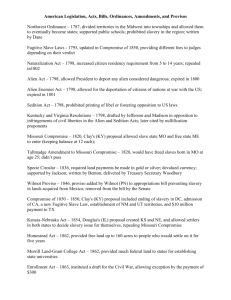Freedom of Speech and Press
advertisement
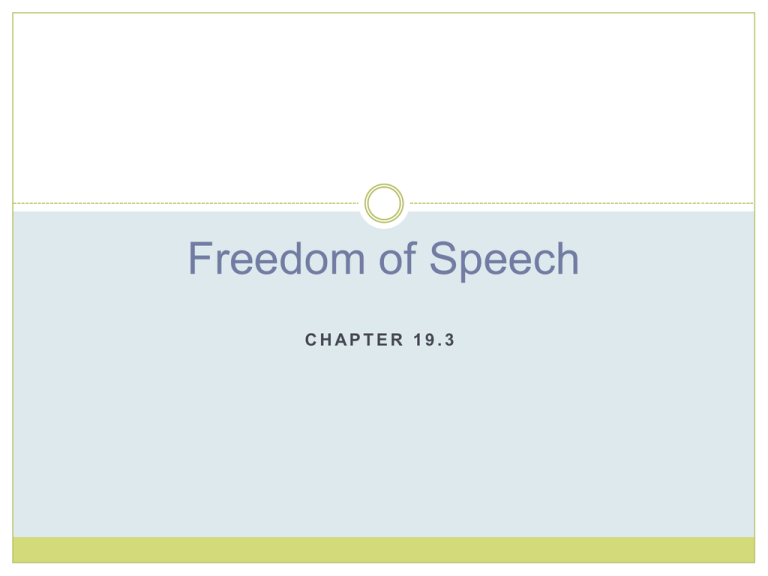
Freedom of Speech CHAPTER 19.3 Free Expression The guarantees of free speech and press in the 1st serves a variety of purposes: To guarantee to each person a right of free expression and thus protect minority and individual rights. To guarantee that the democracy has a full, wide ranging discussion of public affairs. To keep the government accountable To inform the public about information it needs The 1st Amendment gives to all people the right to have their say and the right to hear what others say. 1st Amendment When examining the 1st amendment, keep these two points in mind: 1. The guarantees of free speech and press are intended to protect the expression of unpopular views. Clearly, the opinions of the majority need little or no constitutional protection. 2. Some forms of expression are not protected by the Constitution. No person has an unbridled right of free speech and free press. The Alien and Sedition Acts The Alien and Sedition Acts of 1798 gave the President the power to deport undesirable aliens and made “any false, scandalous, and malicious” criticism of the government a crime. These laws were meant to stifle to opponents of President John Adams and the Federalists. The Alien and Sedition Acts of 1798 were unconstitutional, but that point was never tested in the courts. Some 25 persons were arrested for violating the Alien and Sedition Acts of 1798 (of those, 10 were convicted). The Alien and Sedition Acts of 1798 expired before Thomas Jefferson became president in 1801, and he soon pardoned those who had been affected by them. The Sedition Act of 1917 Espionage Act of 1917 - WWI It is a crime to encourage disloyalty, interfere with the draft, obstruct recruiting, incite insubordination in the armed forces, or hinder the sale of government bonds. Also criminal; “willfully utter, print, write, or publish any disloyal, profane, scurrilous, or abusive language about the form of government in the United States”. 2,000 + convicted Schenck v. United States (1919) Charles Schenck, an officer of the Socialist Party, mailed 15,000 young men fliers urging them to resist the draft. The Supreme Court upheld Schenck’s conviction. The “Clear and Present Danger” Rule Schenck v United States (1919) established “clear and present danger” standard “Words can be weapons…The question in every case is whether the words used are used in such circumstances and are of such nature as to create a clear and present danger that they will bring about the substantive evils that Congress has a right to prevent” (Opinion of the Court) Some words will incite criminal acts and when they do, the speaker can be punished. Consider yelling “fire” in a crowded theatre The Smith Act of 1940 Smith Act of 1940 – WWII. The Smith Act of 1940 makes it a crime for anyone to advocate the violent overthrow of the government of the United States, to distribute any material that teaches or advises violent overthrow, or to knowingly belong to any group with such an aim. Dennis v. United States (1951) 11 Communist Party leaders had been convicted of advocating the overthrow of the Federal Government. On appeal, they argued that the law violated their 1st Amendment freedom of speech and press. They also claimed that no act of theirs constituted a clear and present danger to this country. The court disagreed… “An attempt to overthrow the government by force, even though doomed from the outset because of inadequate numbers of power of the revolutionists, is a sufficient evil for Congress to prevent…” (Chief Justice Fred M. Vinson, Opinion of the Court). Yates v. United States (1957) Court overturned the Smith Act. It held that merely to urge someone to believe something, in contrast to urging the person to do something, cannot be made illegal. In Yates and other Smith Act cases, the Court upheld the constitutionality of the law, but interpreted its provisions so that their enforcement became practically impossible. Brandenberg v Ohio (1968) Brandenburg, a leader in the Ku Klux Klan, made a speech at a Klan rally and was later convicted under an Ohio law that made it illegal to advocate "crime, sabotage, violence, or unlawful methods of terrorism as a means of accomplishing industrial or political reform.“ The court said speech could be punished if it was directed at inciting “imminent unlawful acts.” Symbolic Speech Symbolic speech has less protection than “pure speech” Protected: picketing, flag burning, black armbands Not protected: burning draft cards, burning a cross with the intent to intimidate, camping on the capitol mall The standard: content neutral, the government limits the minimum speech needed to protect a governmental interest Student Speech Tinker v Des Moines (1969) students can wear black armbands to protest Vietnam War so long as there is not a “material and substantial disruption” to the learning environment Bethel v Fraser (1986) School can censor a speech at a school assembly because it was vulgar and bore the imprimatur of the school Morse v Frederick (2007) School can censor a banner proclaiming “bong hits for Jesus” because it promoted drug use – which was clearly counter to the mission of the school
